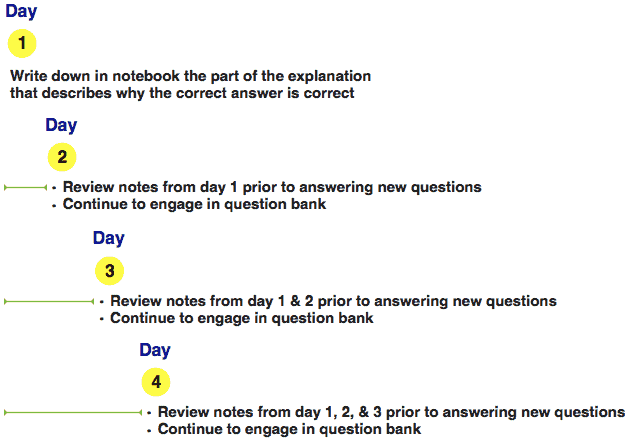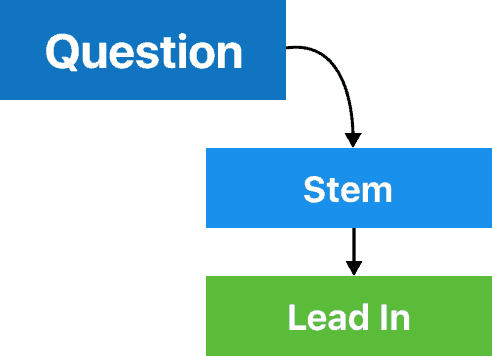How to Increase Your Child & Adolescent Psychiatry Board Exam Score

This article covers two easy strategies to help increase your score and likelihood of passing the American Board of Psychiatry and Neurology (ABPN) Child and Adolescent Psychiatry Certification Exam. These two techniques are useful, easy to implement, and only require a little of your time.
The first strategy is to identify what you don‘t know. Sounds easy, right? The key is to go through a curriculum and identify what you don’t know—not what you are weak at—but what you don’t know. The second strategy is to take advantage of human error. Tests are written by humans, and humans make errors. By paying attention to five types of flaws that question writers make, you can narrow down an answer choice to either the correct answer or a 50/50 probability, even if you don’t know anything about the topic. By combining these two strategies, you’ll be able to increase your child psychiatry board exam score and increase the likelihood of passing the exam. Let’s get started.
Strategy 1: Determining your unknown unknowns
As you begin to study for the child psychiatry boards, you’ll find areas you are comfortable with. Maybe you have a special interest in anxiety disorders and feel confident with any question that might be asked on separation anxiety disorder. Therefore, you spend less time reviewing them. This is one of your known knowns—you know that you know the information. There is little utility in spending too much time on your known knowns when preparing for your exam.
During your training, your understanding of autism spectrum disorder may have been poor. Autism may have been just a term to you. Perhaps you had a poor grasp of the major transition between the DSM-IV and DSM-5 with the subsuming of prior disorders (e.g., Asperger disorder, childhood disintegrative disorder, pervasive developmental disorder) into a single diagnosis of autism spectrum disorder and the different options for specifiers (e.g., associated with a known medical or genetic condition or with catatonia), and you did not understand the requirement for determining severity level based on the degree of behavioral, social, and communicative support the child required. Autism spectrum disorder was a known unknown. By recognizing this specific deficiency, you’re able to target your learning on the new DSM-5 criteria and how to assess severity level.
Once you start to focus you learning, you will come across many concepts and ideas that you know nothing about…never even heard about some of them. These are your unknown unknowns, a concept created by psychologists Joseph Luft and Harrington Ingham. It is part of their “Johari window,” a tool that helps users identify blind spots about themselves and others.
Known unknowns are things you’re aware that you don’t know—you can recognize that you don’t understand them. Unknown unknowns, however, are unexpected because you don’t know they exist.
The way to supercharge your child and adolescent psychiatry board exam score is to identify your unknown unknowns. It takes a little effort, but it is rather easy. All you need are two things:

The system works like this:
Step 1: Answer a question from a question bank. If you get the answer wrong, read the explanation. Then write down in your notebook the part of the explanation that describes why the correct answer is correct. This process helps to identify your unknown unknowns. Subsequently, if there is any other information that you did not know or somewhat knew, record it in your notebook under the same topic.
You should do this for every question you get incorrect. It’s also recommended for questions you may have answered correctly but discovered new information in the explanation that you previously did not know.
Step 2: Start each study session by reviewing your notebook that contains your unknown unknowns. As you do more questions, you’ll incorrectly answer ones on topics already recorded in your notebook. For example, if you answer a question incorrectly on the use of methylphenidate, you’ll record in your notebook something like “methylphenidate: psychostimulants are first-line treatment options for patients with attention-deficit/hyperactivity disorder (ADHD) but are contraindicated in the presence of structural cardiac abnormalities .” If two weeks later you choose psychostimulants as the correct choice for a teenager with ADHD and a substance use disorder, then you should go back through your notebook to find your first entry on psychostimulants and add that nonstimulant medications (e.g., clonidine, atomoxetine) are preferred in the presence of a substance use disorder due to the potential for misuse or diversion of psychostimulants.
After a month or two of recording your incorrect answer explanations, you will have a filled notebook of your unknown unknowns and maybe many of your known unknowns. If you do this on a consistent basis and get through hundreds of question bank questions for a 280-question standardized exam, you’ll identify most of your blind spots that questions can ask about. You will convert your unknown unknowns to known knowns.
Here’s what this process looks like:

With the child psychiatry boards around the corner, now is the perfect time to begin this system. It leaves time for adjustment and plenty of time to accumulate your unknown unknowns.
Strategy 2: Taking advantage of human error
Earlier, this post mentioned that you’ll need two things to supercharge your standardized exam score: a notebook and time. The notebook you can buy anytime. However, time disappears.
Taking the time to identify your unknown unknowns will prepare you for the exam. However, we know five ways you can improve your score simply by showing up to your exam. You can use the errors made by question writers to boost your score.
The Anatomy of a Question
First, let’s understand the anatomy of a question.

Question
A 13-year-old boy has been diagnosed with disruptive mood dysregulation disorder. Although he has episodic verbal aggression, he does not have significant physical aggression. He does not have any comorbid psychiatric disorders. He has experimented with alcohol and unknown pills from a friend on one occasion. What is the mechanism of action of first-line medications recommended in this situation?
A question is made up of the stem and the lead-in. The stem contains the details of the question such as the clinical presentation, past medical history, and laboratory results. But, the critical part of the question is the lead-in. The question writer uses the lead-in to find out what you know or don’t know about the topic in the stem. But it is also where question writers make errors. By applying basic grammatical analysis, you will be able to identify the correct answer or at least narrow down the answer choices without knowing anything about the topic. Here are our first two tips:
1. Pay attention to grammatical cues.
Grammatical cues: one or more answer choices (distractors) don’t follow grammatically from the lead-in.
An 8-year-old boy with autism spectrum disorder has been taking risperidone for 3 months to help with significant irritability. This drug treats irritability through which of the following mechanisms?
A. Blockade of dopamine D2 and serotonin 5-HT2A receptors
B. Dopamine D2 receptor
C. Inhibition of dopamine and norepinephrine reuptake
D. Inhibition of selective serotonin reuptake
E. Mesolimbic pathway
B and E do not follow grammatically from the lead-in. A good test taker can eliminate these.
2. Focus on logical cues.
Logical cues: one or more answer choices don’t logically fit in with the other choices.
Which of the following has been the most clearly implicated in the etiology of intermittent explosive disorder?
A. Elevated serotonergic activity
B. Head trauma
C. Impulsivity
D. Outbursts of anger
E. Prefrontal cortex dysfunction
Impulsivity and outbursts of anger are signs of intermittent explosive disorder, not part of its etiology, and can be eliminated by a good test taker.
Let’s now focus on answer choices to identify a few more areas where we can gain an edge.
The Anatomy of Answer Choices
Question: A 14-year-old boy demonstrates abnormalities of smooth pursuit eye movement. Which of the following conditions is consistent with this finding?
A. Autism spectrum disorder
B. Body dysmorphic disorder
C. Schizophrenia
D. Sleepwalking
E. Tourette disorder
Correct answer: C
Distractors: A, B, D, E
The lead-in asks about the most likely diagnosis, so think carefully through each answer option. Here are the explanations:
C. Schizophrenia: potential biomarkers include smooth pursuit eye movement alterations and saccadic eye movement disinhibition.
A. Autism spectrum disorder: associated with gaze aversion in studies of eye tracking. In particular, affected individuals are observed to focus on the lower portion of the faces rather than to make eye contact.
B. Body dysmorphic disorder: affected individuals focus on perceived bodily flaws rather than to see themselves holistically. Treatment is a modified cognitive behavior that includes a perceptual retraining component.
D. Sleepwalking: nonrapid eye movement (NREM) sleep arousal disorders include sleep terror and sleepwalking types. The sleepwalking type is further specified regarding the presence of sleep-related eating or sexual behavior.
E. Tourette disorder: a diagnosis requires the presence of both multiple motor and one or more vocal tics during the course of the illness. Common motor tics include eye blinking, shoulder shrugging, and extension of the extremities.
Once you understand the goal of the question writer to create answer choices that are supposed to discriminate knowledge, it is easier to exploit technical flaws and improve the odds of getting a question correct. The following three pointers round out our five tips that can help you answer a question correctly:
3. Look for answer choices containing absolute terms.
Absolute terms: terms such as “always” or “never.” When used in the answer options, these terms usually indicate an incorrect answer because they cannot hold up to scrutiny in all situations.
Which of the following characteristics of stealing is most consistent with a diagnosis of kleptomania?
A. Always occurs during mania
B. Committed for vengeance
C. Lack of remorse for stealing
D. Never occurs during mania
E. Sense of relief after stealing
A and D contain the absolute terms “always” and “never.” These should be avoided in answer choices because they are less likely to be true statements.
4. Keep an eye out for a long correct answer.
Long correct answer: the correct answer is longer, more specific, or more complete than the other options.
Fear of which of the following is a specifier of specific phobia?
A. Crowds
B. Natural environment, such as heights or storms
C. Open spaces
D. Panic attacks
E. Public speaking
Option B is longer than the other options. The writers tend to pay more attention to the correct answer than to the distractors and write long correct answers that include additional instructional material, parenthetical information, and caveats.
5. Notice when a word repeats.
Word repeats: a word or phrase is included in the stem and in the correct answer.
A 17-year-old girl with a history of major depression and post-traumatic stress disorder presents to the emergency department and reports experiencing the world as seeming unreal around her. What is the term for this symptom?
A. Depersonalization
B. Derailment
C. Derealization
D. Focal memory deficit
E. Identity disturbance
This question uses the term “unreal” in the question stem, and “derealization” is the correct answer.
When you take your child and adolescent psychiatry boards, there is so much at stake. Taking the time to identify your unknown unknowns will not only help you prepare for and excel on your exam, it will help you expand your core knowledge. Then, on test day, use the five simple techniques to identify common flaws in questions, which will increase your chances of getting a question correct.
Give these methods a try and let us know how it goes in the comments section. Moreover, we’d love to hear about techniques you use that we didn’t write about.
And if you’re looking for a child and adolescent psychiatry question bank, you know where to find one.
Best,
The Rosh Review team





Comments (0)